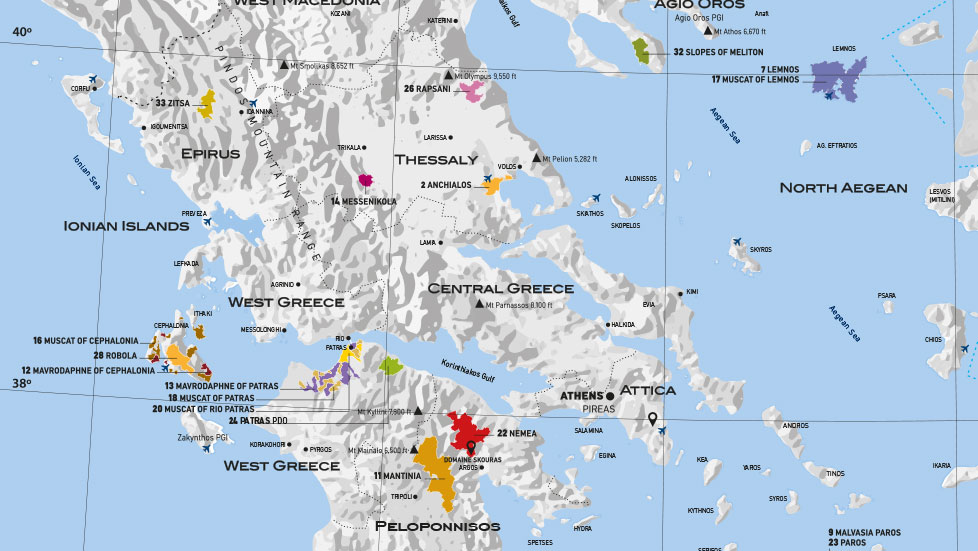Education
Learn more about our wine with our map of Greek wine regions, our video library, and our pronunciation guide.

Greek Regional Wine Map
Enjoy a look at our detailed map of the wine regions of Greece.
Common Greek Varietals
Checkout our varietal overview and pronunciation guide.
Agiorghitiko [ Ah yor yee' ti ko ]
Also called Saint George, this variety is most commonly found in Nemea. A low- to medium-yielding variety producing medium- to high-acid wines depending on elevations and soil profiles. Deep red fruits (plum and cherry) and spice. Considered to be one of Greece’s best red varietals and biggest producing red variety.
Kotsifali [ Ko tsi fah' lee ]
Native to Crete. Produces aromatic, rich, full-bodied wines with low acidity and soft tannins. The wines are never deep in color as this is a thin-skinned grape.
Liatiko [ Lee ah' ti ko ]
Liatiko has a relatively low color intensity, verging on the garnet. The wine is intense, with rich, ripe red fruit and sweet spices. The palate is full, with high levels of alcohol, low and very soft tannins. Long barrel aging is essential usually in large, old oak barrels. It is found all over Crete but the best wines are found in Heraklion, in the PDO Dafnes zone, and in Lasithi, in PDO Sitia.
Limnio [ Lim nee o' ]
Common in northern Greece,where it often appears in blends. Tends to make powerful, structured wines with tangy red fruit and fresh herb qualities and moderate to high acidity.
Mandilaria [ Mahn dee lar ya' ]
A thick-skinned variety from Crete. Produces deeply colored, low-acid and fullbodied wines, often with pronounced tannins. Widely used in blends for the color it brings.
Mavrodaphne [ Mav ro tha'f nee ]
Yields full-bodied, dense wines. Most often used to make rich dessert-styled versions.
Xinomavro [ Ksee no' ma vro ]
Considered one of Greece’s greatest red varietals and responsible for its most serious reds. Notoriously fickle to grow, it is a late-ripening variety, producing powerful, structured, richly flavored wines with solid tannins. The wines are seldom dark and are sometimes compared to Nebbiolo.
Mavrotragano [ Mav ro trah' gah no]
A rare native variety of Santorini which until recently was presumed extinct. Several small producers, mainly Domaine Sigalas, have resurrected the variety, which produces rich extracted red wines with black fruit characteristics and high acidity and velvety tannins.
Assyrtiko [ A seer' tee ko ]
High-acid variety native to Santorini and the Aegean islands, considered by many to make Greece’s finest whites. Usually used to make dry, racy wines with strong mineral character.
Athiri [ Ah thee' ree ]
Athiri is one of the most ancient of Greek grape varieties.The name of the grape indicates its origin from the Island of Santorini, also known as Thira, where it is used together with Assyrtiko and Aidani for the production of AOC Santorini wines. Athiri is found in other regions in Greece including Macedonia, Attica and Rhodes where it produces AOC Rhodes wines. Athiri grapes have a thin skin and give sweet and fruity juice. It produces wines slightly aromatic, having medium alcoholic content with low acidity.
Lagorthi [ La gor' thee ]
A high-acid variety producing crisp, energetic wines with low alcohol, solid structure and pronounced minerality.
Malagousia [ Mah lah gou zya' ]
Malagousia originated in the region of Nafpaktos in western Greece. It is found mainly in Macedonia and is now cultivated in some vineyards in Attica and the Peloponnese. It is an especially aromatic grape leading to elegant full bodied wines, with medium acidity and exciting aromas of exotic fruits, citrus, jasmine and mint.
Moscofilero [ Mos ko fee' le ro ]
A light pink-skinned variety used to produce lively, crisp wines as well as richer, fuller-bodied versions, most of them best suited for drinking on the young side. Usually intensely fragrant, even pungent, with bright citrus character.
Robola [ Ro bo' la ]
Known as Ribolla in Italy. Produces fresh, tangy wines with bright citrus and zesty mineral character.
Roditis [ Ro dee' tees ]
Common in the Peloponnese. A late-ripening, vigorous variety that yields light, crisp wines with fresh citrus and herb character.
Savatiano [ Sa va tya no' ]
The most planted grape in Greece. A high-yielding variety that produces lowacid, early-maturing wines which are often high in alcohol. This is the most common variety used for retsina and is usually blended with other higher-acid grapes.
Vidiano [ Vee thee ah no' ]
Vidiano is a variety found in Crete. It produces wines with lemony green color, intense, individual and very complex aromas of ripe peach and apricot, hints of aromatic herbs and minerality. On the palate they are full and have elevated levels of alcohol, but the moderately high acidity keeps them in balance. The style of Vidiano can be rich but never hot or dull. Most producers try to unlock the true potential of the grape, planting it in cooler high altitude vineyards or blending it with other varieties, like Vilana.
Vilana [ Vee lah nah' ]
Vilana is a Cretan varietal that produces fresh, low alcohol wines and often blended with Vidiano. At its best, Vilana produces Granny Smith fruit on the nose and mouth.
Videos
Enjoy our archive of fun and educational videos.